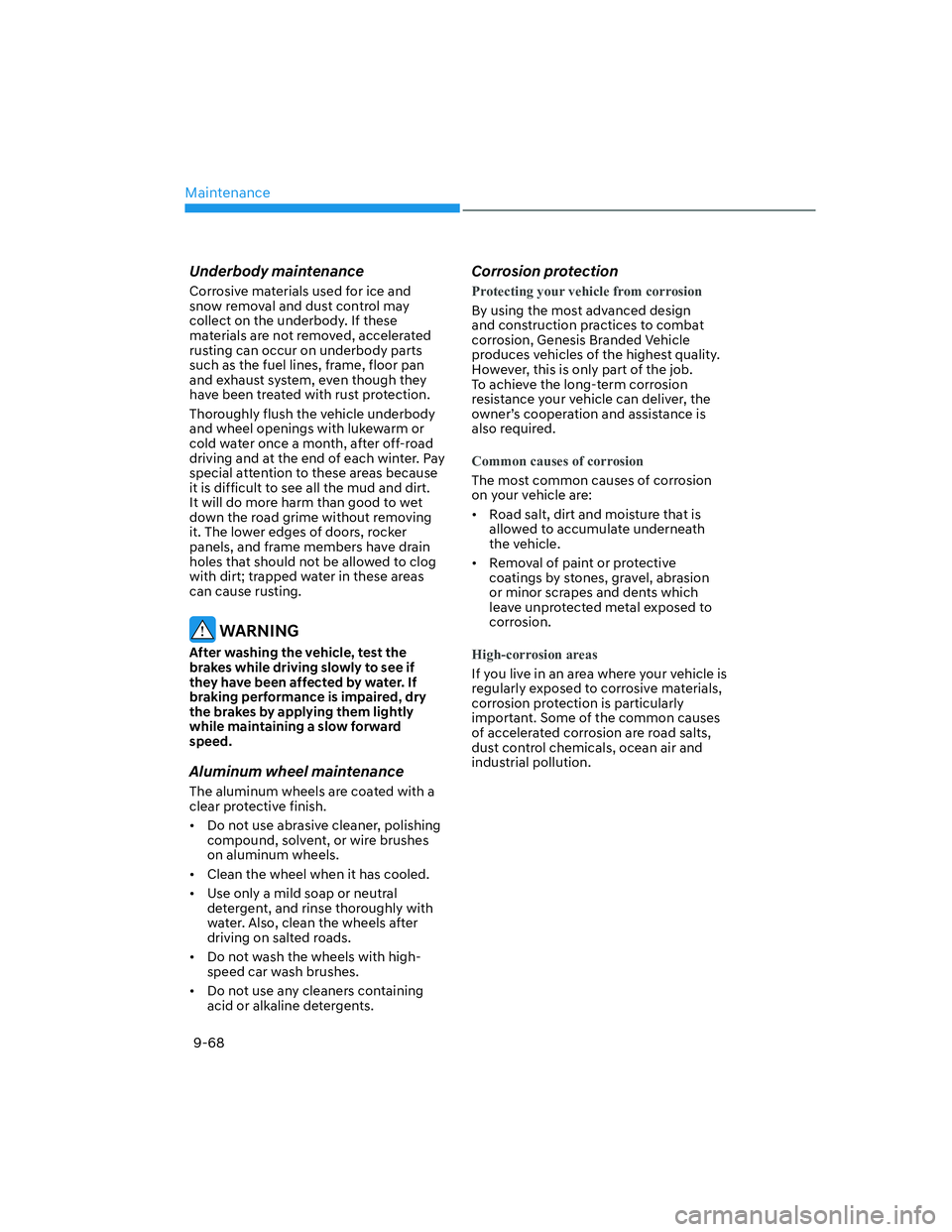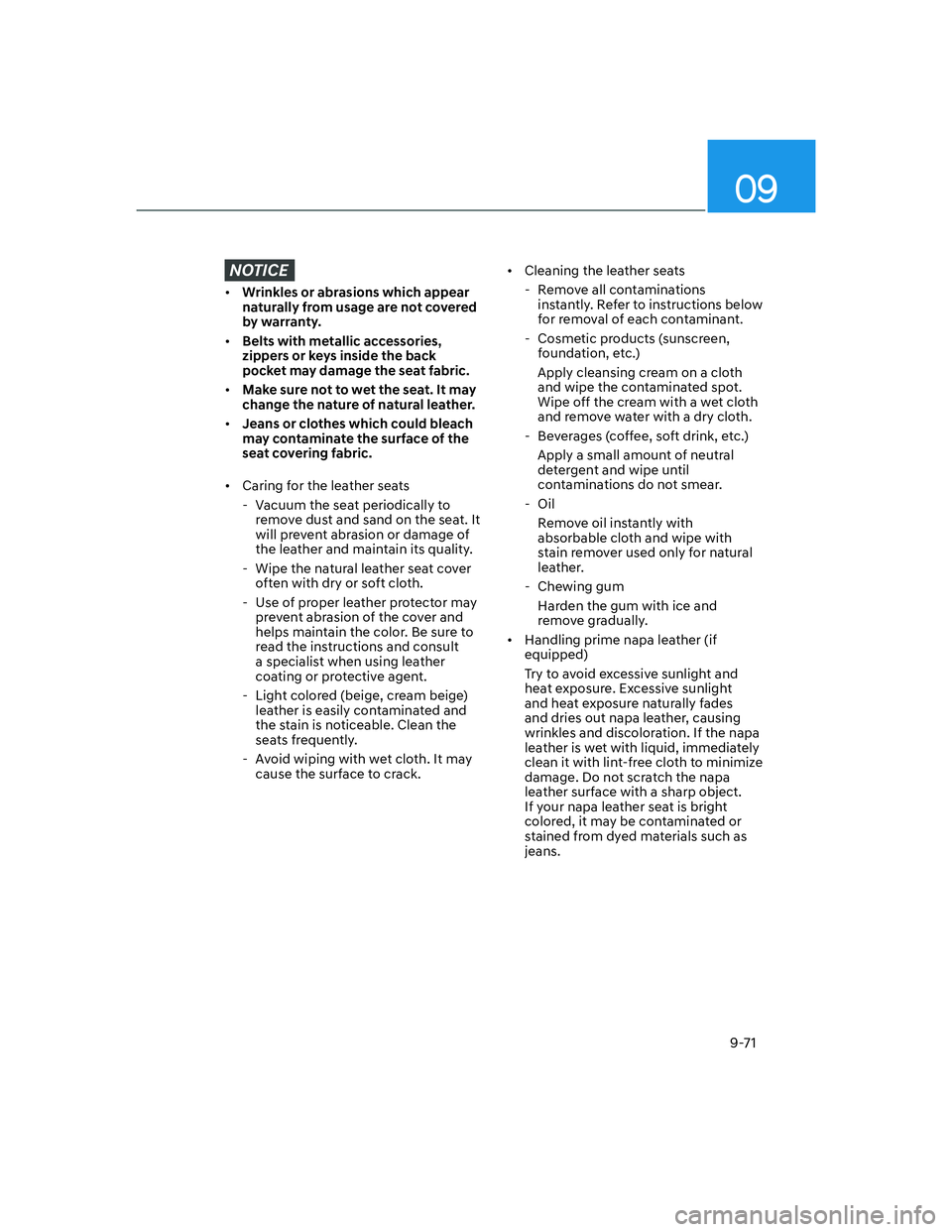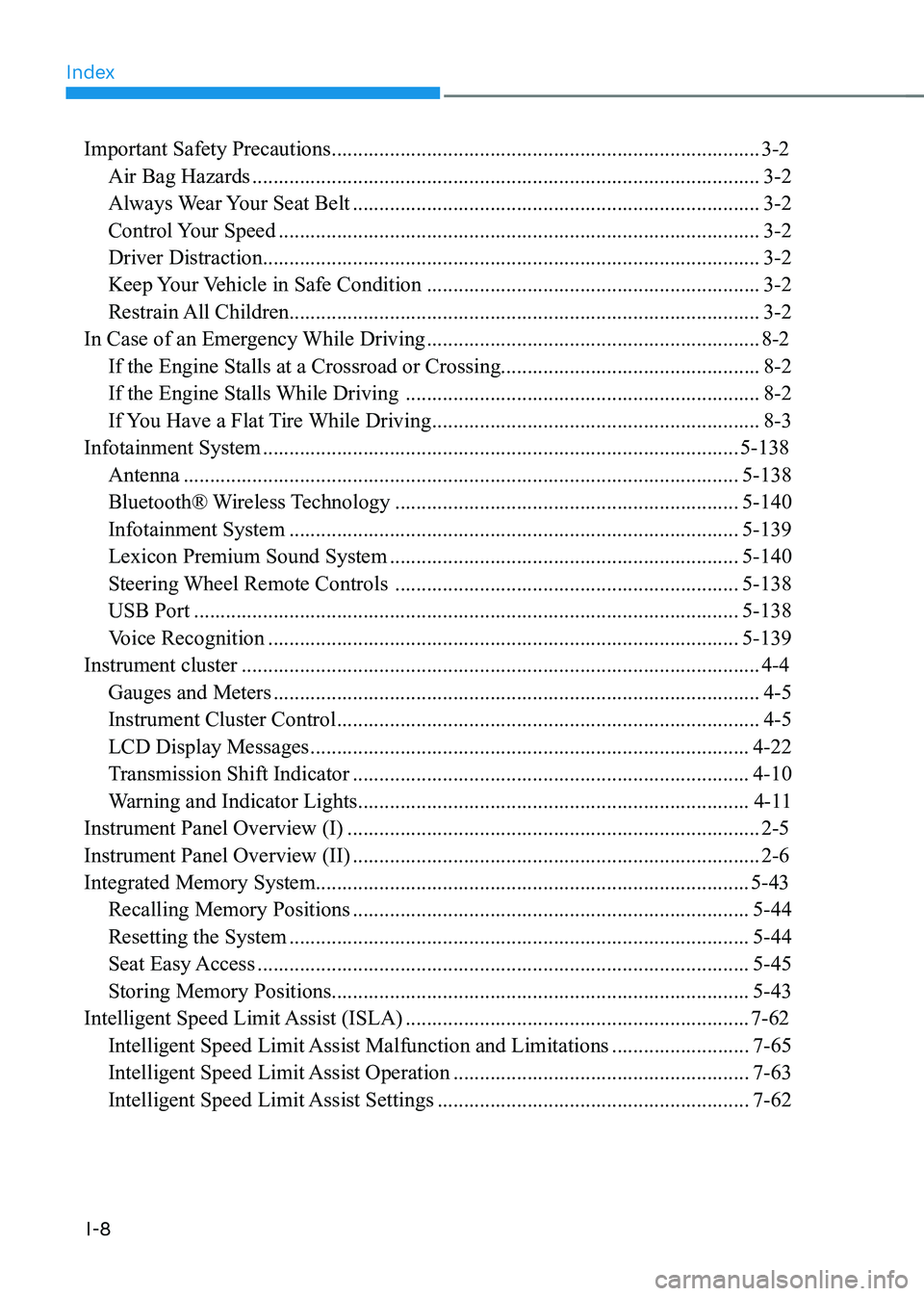2021 HYUNDAI GENESIS GV70 light
[x] Cancel search: lightPage 622 of 647

09
9-65
Exterior Care
NOTICE
If you park your vehicle near a stainless
steel sign or glass facade building, the
vehicle’s exterior plastic parts such
as a bumper, spoiler, garnish, lamp
or outside rearview mirror might be
damaged due to sunlight reflected from
the sign or building. To prevent damage
of the exterior plastic parts, you should
avoid parking in areas where light may
be reflected or use a car cover. (The
exterior plastic parts applied to your
vehicle may vary.)
Exterior general caution
It is very important to follow the label
directions when using any chemical
cleaner or polish. Read all warning and
caution statements that appear on the
label.
Finish maintenance
Washing
To help protect your vehicle’s finish from
rust and deterioration, wash it thoroughly
and frequently at least once a month
with lukewarm or cold water.
If you use your vehicle for off-road
driving, you should wash it after each
off-road trip. Pay special attention to the
removal of any accumulation of salt, dirt,
mud, and other foreign materials. Make
sure the drain holes in the lower edges
of the doors and rocker panels are kept
clear and clean.Insects, tar, tree sap, bird droppings,
industrial pollution and similar deposits
can damage your vehicle’s finish if not
removed immediately.
Even prompt washing with plain water
may not completely remove all these
deposits. A mild soap, safe for use on
painted surfaces, should be used.
After washing, rinse the vehicle
thoroughly with lukewarm or cold water.
Do not allow soap to dry on the finish.
High-pressure washing
• When using high-pressure washers,
make sure to maintain sufficient
distance from the vehicle.
Insufficient clearance or excessive
pressure can lead to component
damage or water penetration.
• Do not spray the camera, sensors or
its surrounding area directly with a
high pressure washer. Shock applied
from high pressure water may cause
the device to not operate normally.
• Do not bring the nozzle tip close to
boots (rubber or plastic covers) or
connectors as they may be damaged
if they come into contact with high
pressure water.
WARNING
After washing the vehicle, test the
brakes while driving slowly to see
if they have been affected by water
before getting on the road. If braking
performance is impaired, dry the
brakes by applying them lightly while
maintaining a slow forward speed.
APPEARANCE CARE
Page 623 of 647

Maintenance
9-66
NOTICE
• Do not use strong soap, chemical
detergents or hot water, and do not
wash the vehicle in direct sunlight
or when the body of the vehicle is
warm.
• Be careful when washing the side
windows of your vehicle.
• Especially, with high-pressure water,
water may leak through the windows
and wet the interior.
• To prevent damage to the plastic
parts, do not clean with chemical
solvents or strong detergents.
NOTICE
OJK090026OJK090026
• Water washing in the engine
compartment including high
pressure water washing may cause
the failure of electrical circuits
located in the engine compartment.
• Never allow water or other liquids
to come in contact with electrical/
electronic components inside the
vehicle as this may damage them.
NOTICE
Matte paint finish vehicle (if equipped)
Automatic car wash which uses rotating
brushes should not be used as this can
damage the surface of your vehicle. A
steam cleaner which washes the vehicle
surface at high temperature may result
the oil to adhere and leave stains that is
difficult to remove.
Use a soft cloth (e.g. microfiber towel
or sponge) when washing your vehicle
and dry with a microfiber towel. When
you hand wash your vehicle, you should
not use a cleaner that finishes with wax.
If the vehicle surface is too dirty (sand,
dirt, dust, contaminant, etc.), clean the
surface with water before washing the
car.
Waxing
A good coat of wax is a barrier between
your paint and contaminate. Keeping
a good coat of wax on your vehicle will
help protect it.
Wax the vehicle when water will no
longer bead on the paint.
Always wash and dry the vehicle before
waxing. Use a good quality liquid or
paste wax, and follow the manufacturer’s
instructions. Wax all metal trim to protect
it and to maintain its luster.
Removing oil, tar, and similar materials
with a spot remover will usually strip the
wax from the finish. Be sure to re-wax
these areas even if the rest of the vehicle
does not yet need waxing.
Page 625 of 647

Maintenance
9-68
Underbody maintenance
Corrosive materials used for ice and
snow removal and dust control may
collect on the underbody. If these
materials are not removed, accelerated
rusting can occur on underbody parts
such as the fuel lines, frame, floor pan
and exhaust system, even though they
have been treated with rust protection.
Thoroughly flush the vehicle underbody
and wheel openings with lukewarm or
cold water once a month, after off-road
driving and at the end of each winter. Pay
special attention to these areas because
it is difficult to see all the mud and dirt.
It will do more harm than good to wet
down the road grime without removing
it. The lower edges of doors, rocker
panels, and frame members have drain
holes that should not be allowed to clog
with dirt; trapped water in these areas
can cause rusting.
WARNING
After washing the vehicle, test the
brakes while driving slowly to see if
they have been affected by water. If
braking performance is impaired, dry
the brakes by applying them lightly
while maintaining a slow forward
speed.
Aluminum wheel maintenance
The aluminum wheels are coated with a
clear protective finish.
• Do not use abrasive cleaner, polishing
compound, solvent, or wire brushes
on aluminum wheels.
• Clean the wheel when it has cooled.
• Use only a mild soap or neutral
detergent, and rinse thoroughly with
water. Also, clean the wheels after
driving on salted roads.
• Do not wash the wheels with high-
speed car wash brushes.
• Do not use any cleaners containing
acid or alkaline detergents.
Corrosion protection
Protecting your vehicle from corrosion
By using the most advanced design
and construction practices to combat
corrosion, Genesis Branded Vehicle
produces vehicles of the highest quality.
However, this is only part of the job.
To achieve the long-term corrosion
resistance your vehicle can deliver, the
owner’s cooperation and assistance is
also required.
Common causes of corrosion
The most common causes of corrosion
on your vehicle are:
• Road salt, dirt and moisture that is
allowed to accumulate underneath
the vehicle.
• Removal of paint or protective
coatings by stones, gravel, abrasion
or minor scrapes and dents which
leave unprotected metal exposed to
corrosion.
High-corrosion areas
If you live in an area where your vehicle is
regularly exposed to corrosive materials,
corrosion protection is particularly
important. Some of the common causes
of accelerated corrosion are road salts,
dust control chemicals, ocean air and
industrial pollution.
Page 628 of 647

09
9-71
NOTICE
• Wrinkles or abrasions which appear
naturally from usage are not covered
by warranty.
• Belts with metallic accessories,
zippers or keys inside the back
pocket may damage the seat fabric.
• Make sure not to wet the seat. It may
change the nature of natural leather.
• Jeans or clothes which could bleach
may contaminate the surface of the
seat covering fabric.
• Caring for the leather seats
- Vacuum the seat periodically to
remove dust and sand on the seat. It
will prevent abrasion or damage of
the leather and maintain its quality.
- Wipe the natural leather seat cover
often with dry or soft cloth.
- Use of proper leather protector may
prevent abrasion of the cover and
helps maintain the color. Be sure to
read the instructions and consult
a specialist when using leather
coating or protective agent.
- Light colored (beige, cream beige)
leather is easily contaminated and
the stain is noticeable. Clean the
seats frequently.
- Avoid wiping with wet cloth. It may
cause the surface to crack.• Cleaning the leather seats
- Remove all contaminations
instantly. Refer to instructions below
for removal of each contaminant.
- Cosmetic products (sunscreen,
foundation, etc.)
Apply cleansing cream on a cloth
and wipe the contaminated spot.
Wipe off the cream with a wet cloth
and remove water with a dry cloth.
- Beverages (coffee, soft drink, etc.)
Apply a small amount of neutral
detergent and wipe until
contaminations do not smear.
- Oil
Remove oil instantly with
absorbable cloth and wipe with
stain remover used only for natural
leather.
- Chewing gum
Harden the gum with ice and
remove gradually.
• Handling prime napa leather (if
equipped)
Try to avoid excessive sunlight and
heat exposure. Excessive sunlight
and heat exposure naturally fades
and dries out napa leather, causing
wrinkles and discoloration. If the napa
leather is wet with liquid, immediately
clean it with lint-free cloth to minimize
damage. Do not scratch the napa
leather surface with a sharp object.
If your napa leather seat is bright
colored, it may be contaminated or
stained from dyed materials such as
jeans.
Page 630 of 647

09
9-73
The emission control system of your
vehicle is covered by a written limited
warranty. Please see the warranty
information contained in the Owner’s
Handbook & Warranty Information
booklet in your vehicle.
Your vehicle is equipped with an
emission control system to meet all
applicable emission regulations. There
are three emission control systems, as
follows.
(1) Crankcase emission control system
(2) Evaporative emission control system
(3) Exhaust emission control system
In order to ensure the proper function
of the emission control systems, it
is recommended that you have your
vehicle inspected and maintained by an
authorized retailer of Genesis Branded
products in accordance with the
maintenance schedule in this manual.
NOTICE
For the Inspection and Maintenance
Test (with Electronic Stability Control
(ESC) system)
• To prevent the vehicle from misfiring
during dynamometer testing, turn
the Electronic Stability Control
(ESC) system off by pressing the ESC
switch (ESC OFF light illuminated).
• After dynamometer testing is
completed, turn the ESC system back
on by pressing the ESC switch again.
1. Crankcase Emission Control
System
The positive crankcase ventilation system
is employed to prevent air pollution
caused by blow-by gases being emitted
from the crankcase. This system supplies
fresh filtered air to the crankcase through
the air intake hose. Inside the crankcase,
the fresh air mixes with blow-by gases,
which then pass through the PCV valve
into the induction system.
2. Evaporative Emission Control
System including Onboard
Refueling Vapor Recovery
(ORVR)
The Evaporative Emission Control System
is designed to prevent fuel vapors from
escaping into the atmosphere. The
ORVR system is designed to allow the
vapors from the fuel tank to be loaded
into a canister while refueling at the gas
station, preventing the escape of fuel
vapors into the atmosphere.
Canister
Fuel vapors generated inside the fuel
tank are absorbed and stored in the
onboard canister. When the engine is
running, the fuel vapors absorbed in the
canister are drawn into the surge tank
through the purge control solenoid valve.
Purge Control Solenoid Valve (PCSV)
The purge control solenoid valve
is controlled by the Engine Control
Module (ECM); when the engine coolant
temperature is low during idling, the
PCSV closes so that evaporated fuel
is not taken into the engine. After the
engine warms-up during ordinary
driving, the PCSV opens to introduce
evaporated fuel to the engine.
EMISSION CONTROL SYSTEM
Page 640 of 647

Index
I-8
Important Safety Precautions ........................................................................\
.........3-2
Air Bag Hazards ........................................................................\
........................3-2
Always Wear Your Seat Belt ........................................................................\
.....3-2
Control Your Speed ........................................................................\
...................3-2
Driver Distraction........................................................................\
......................3-2
Keep Your Vehicle in Safe Condition ...............................................................3-2
Restrain All Children........................................................................\
.................3-2
In Case of an Emergency While Driving ...............................................................8-2
If the Engine Stalls at a Crossroad or Crossing.................................................8-2
If the Engine Stalls While Driving ...................................................................8-2
If You Have a Flat Tire While Driving ..............................................................8-3
Infotainment System ........................................................................\
..................5-138
Antenna ........................................................................\
.................................5-138
Bluetooth® Wireless Technology .................................................................5-140
Infotainment System ........................................................................\
.............5-139
Lexicon Premium Sound System ..................................................................5-140
Steering Wheel Remote Controls .................................................................5-138
USB Port ........................................................................\
...............................5-138
Voice Recognition ........................................................................\
.................5-139
Instrument cluster ........................................................................\
..........................4-4
Gauges and Meters ........................................................................\
....................4-5
Instrument Cluster Control ........................................................................\
........4-5
LCD Display Messages ........................................................................\
...........4-22
Transmission Shift Indicator ........................................................................\
...4-10
Warning and Indicator Lights ........................................................................\
..4-11
Instrument Panel Overview (I) ........................................................................\
......2-5
Instrument Panel Overview (II) ........................................................................\
.....2-6
Integrated Memory System........................................................................\
..........5-43
Recalling Memory Positions ........................................................................\
...5-44
Resetting the System ........................................................................\
...............5-44
Seat Easy Access ........................................................................\
.....................5-45
Storing Memory Positions........................................................................\
.......5-43
Intelligent Speed Limit Assist (ISLA) .................................................................7-62
Intelligent Speed Limit Assist Malfunction and Limitations ..........................7-65
Intelligent Speed Limit Assist Operation ........................................................7-63
Intelligent Speed Limit Assist Settings ...........................................................7-62
Page 642 of 647

Index
I-10
Light Bulbs ........................................................................\
..................................9-60
Headlamp, Position Lamp, Turn Signal Lamp, Daytime Running Light (DRL) Replacement ........................................................................\
................9-61
High Mounted Stop Lamp Replacement .........................................................9-63
Interior Light Replacement ........................................................................\
.....9-63
License Plate Lamp Replacement ...................................................................9-63
Puddle Lamp Replacement ........................................................................\
.....9-62
Rear Combination Lamp Replacement ...........................................................9-62
Lighting ........................................................................\
.......................................5-88
Exterior Lights ........................................................................\
........................5-88
Interior Lights........................................................................\
..........................5-92
Welcome System ........................................................................\
.....................5-95
M
Maintenance Services ........................................................................\
....................9-4
Owner Maintenance Precautions.......................................................................9-4
Owner’s Responsibility ........................................................................\
.............9-4
Manual Speed Limit Assist (MSLA) ...................................................................7-59
Manual Speed Limit Assist Operation ............................................................7-59
Mirrors ........................................................................\
.........................................5-51
Inside Rearview Mirror ........................................................................\
...........5-51
Reverse Parking Aid ........................................................................\
................5-62
Side View Mirrors ........................................................................\
...................5-60
N
Navigation-Based Smart Cruise Control (NSCC) ...............................................7-98
Limitations of Navigation-Based Smart Cruise Control ...............................7-101
Navigation-Based Smart Cruise Control Operation ........................................7-99
Navigation-Based Smart Cruise Control Settings ...........................................7-98
O
Owner Maintenance ........................................................................\
.......................9-5
Owner Maintenance Schedule........................................................................\
...9-6
Page 644 of 647

Index
I-12
Reverse Parking Distance Warning (PDW) .......................................................7-141
Reverse Parking Distance Warning Malfunction and Precautions ................7-143
Reverse Parking Distance Warning Operation ..............................................7-142
Reverse Parking Distance Warning Settings .................................................7-141
S
Safe Exit Assist (SEA) ........................................................................\
.................7-52
Safe Exit Assist Malfunction and Limitations ................................................7-56
Safe Exit Assist Operation ........................................................................\
......7-54
Safe Exit Assist Settings........................................................................\
..........7-53
Safe Exit Warning (SEW) ........................................................................\
............7-46
Safe Exit Warning Malfunction and Limitations ............................................7-49
Safe Exit Warning Operation ........................................................................\
..7-48
Safe Exit Warning Settings ........................................................................\
.....7-47
Scheduled Maintenance Services ........................................................................\
..9-7
Maintenance Under Severe Usage Conditions ................................................9-11
Normal Maintenance Schedule ........................................................................\
.9-8
Seat Belts ........................................................................\
.....................................3-25
Additional Seat Belt Safety Precautions .........................................................3-34
Care of Seat Belts ........................................................................\
....................3-36
Pre-Active Seat Belt (PSB) ........................................................................\
.....3-33
Seat Belt Restraint System ........................................................................\
......3-27
Seat Belt Safety Precautions ........................................................................\
...3-25
Seat Belt Warning Light ........................................................................\
..........3-26
Seats ........................................................................\
...............................................3-3
Air Ventilation Seats ........................................................................\
...............3-23
Front Seats ........................................................................\
.................................3-7
Head Restraint ........................................................................\
.........................3-16
Rear Seats ........................................................................\
................................3-12
Safety Precautions ........................................................................\
.....................3-6
Seat Warmers ........................................................................\
...........................3-20
Smart Cruise Control (SCC) ........................................................................\
.......7-79
Smart Cruise Control Display and Control .....................................................7-85
Smart Cruise Control Malfunction and Limitations........................................7-91
Smart Cruise Control Operation......................................................................7-84
Smart Cruise Control Settings ........................................................................\
.7-80